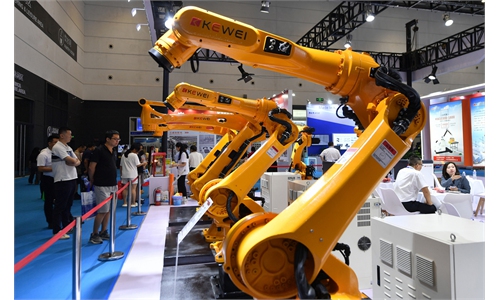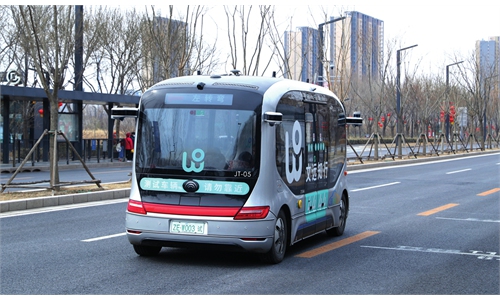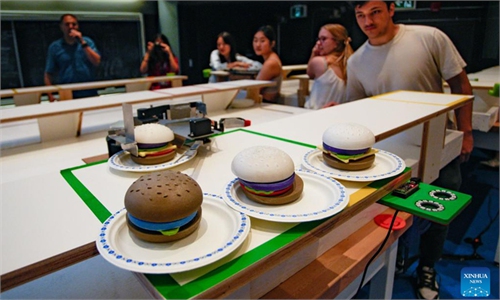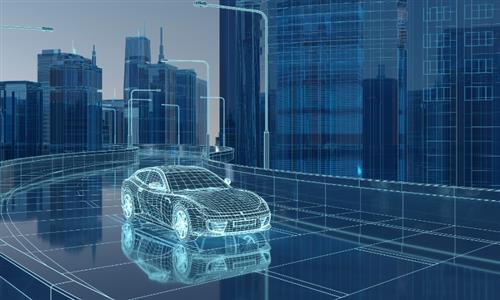Future in China: Robot services become a common sight
New drivers and strengths fuel high-quality development
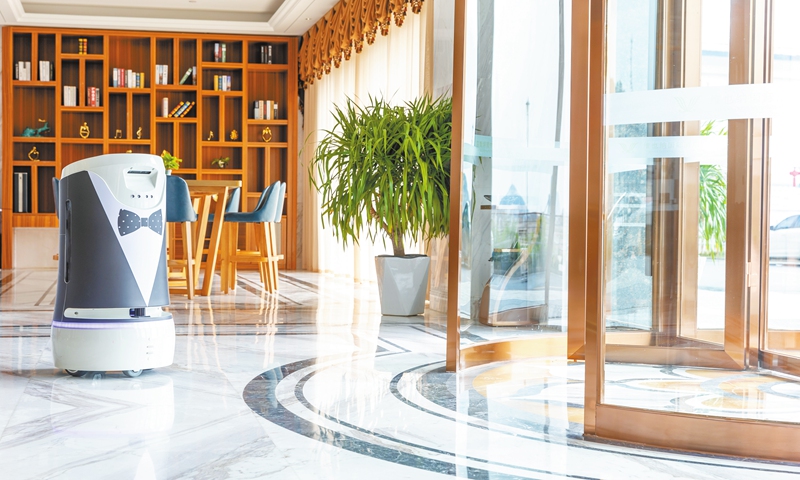
Concept photo of a service robot at a hotel lounge Illustration: VCG
"So cool! Wow!" Foreign travel vloggers were left stunned by service robots delivering food to their hotel rooms in China.
The hashtag "China hotel" has become a new trending keyword for many overseas social media and video platforms, after "China travel" went viral.
Ken Abroad, a travel vlogger from Germany, shared his experience of being served by a room service robot in a hotel in Shanghai.
"Okay, so the phone is ringing. That means the robot is here," he said at the beginning of the video.
When he opened the door, he saw a robot standing there waiting for him. When he pressed the "open" button on the machine, the lid on the top opened to reveal the food he had ordered inside. He took out the package and hit "finished" to close the compartment and watched the robot return to the elevator.
Service robots can take elevators on their own, which was revealed in other vloggers' videos.
These robots, or intelligent machines, deliver food, mail, express packages and amenities ordered by hotel guests through room service. The robots can deliver 70 to 80 loads a day, a Shenzhen-based service robot designer told the Global Times.
"When the robot detects that it is very close to people, it will stop, but the current distance is still too large, which also makes it difficult for the robot to work when areas become crowded. We are now optimizing the distance measurement module and training the machine in obstacle avoidance through artificial intelligence (AI)," said the designer.
Apart from room service robots, foreign tourists were also attracted by automated curtains, wireless charging facilities and intelligent voice control system which are often featured in Chinese hotels.
The futuristic reality showcases China's sci-tech development in the past few years.
Rapid development
China's robot industry has developed rapidly over recent years.
Last week, China's first licensed AI catering robot arrived in Beijing. The robot can be trained to make pancakes and wrap and steam steamed buns, local media reported.
Currently, several stalls providing on-site robot-made pancakes have been installed in several metro stations in the Chinese capital.
From intelligent food delivery robots to robotic tour guides in shopping malls and museums, and even street inspection robots, China's diverse applications of service robots and unmanned technology showcase the country's emerging industries and future industrial development.
Robots and automatic machines are already replacing redundant, low-value-added and often dangerous work across the country.
"Freeing employees from repetitive and low value-added work - to do some work that can only be done by humans - enables employees to focus more on providing higher quality services," a veteran expert on hotel management surnamed Zheng, told the Global Times.
In addition, most hotels in China with three stars or more are now equipped with service robots. If a hotel is not equipped, then the guests who have been accustomed to the robot service may think that the hotel's service is not comprehensive enough and will not choose this hotel again next time, Zheng noted.
The scale of the service robot industry has maintained a rapid growth rate. At the same time, China's industrial robots are also catching up with this emerging technological trend.
China has been the world's largest industrial robot market for 11 consecutive years. China's industrial robot market sales increased from 70,000 units in 2015 to 316,000 units in 2023, accounting for 53.6 percent of the total global sales in 2023, according to statistics released at a press briefing on August 13 for the World Robot Conference.
China is the world's largest producer of robots, with industrial robot production growing from 33,000 units in 2015 to 430,000 units in 2023, accounting for 72.9 percent of the global output in 2023, statistics showed. The output of China's service robots in 2023 totaled 7.833 million units, an increase of 21.3 percent year on year.
Top-down effort
Robots and other future-oriented industries such as the metaverse and brain-computer interfaces are key to the development and application of new quality productive forces that encompass emerging industries.
Developing new quality productive forces that may create disruptive technological advances in the era of intelligent information is a decisive step in the economy's high-quality development course.
China will establish a mechanism for ensuring funding increases for industries of the future, improve the policy and governance systems for promoting the development of strategic industries such AI, according to the resolution adopted at the Third Plenary Session of the 20th Central Committee of the Communist Party of China in July.
Future industries are crucial for countries aiming to capitalize on the opportunities presented by the new wave of scientific and technological revolution and industrial transformation.
In late January, China released guidelines on the innovation and development of "future industries," focusing on future-oriented manufacturing, information, materials, energy, space and health.
As early as in 2021, the future industries were included in China's Outline of the 14th Five-Year Plan (2021-25) for National Economic and Social Development (2021-25) and Vision 2035.
China has invested significant resources and talent into cutting-edge technologies including AI, brain-like intelligence, quantum technology, atomic-scale manufacturing, bio-manufacturing, humanoid robotics, low-altitude economy and hydrogen energy.
Many provinces and cities in China have prioritized the development of future industries, with many having focused on efforts in key areas such as robotics, AI, commercial aerospace, and low-altitude economy, to promote industrial innovation and enhance new momentum for economic growth.
The results are beginning to show. For example, the output of service robots in July increased by 41.6 percent year-on-year and that of industrial robots increased by 19.7 percent. Meanwhile, the output of civilian drones grew by 84.7 percent, according to statistics released by the National Bureau of Statistics on Thursday.
